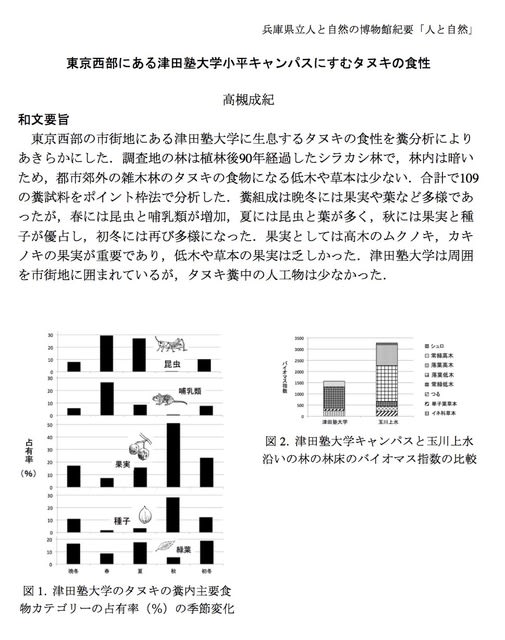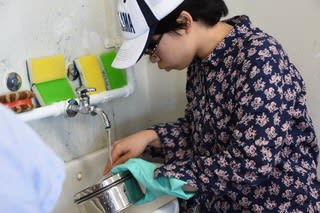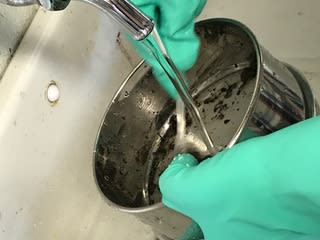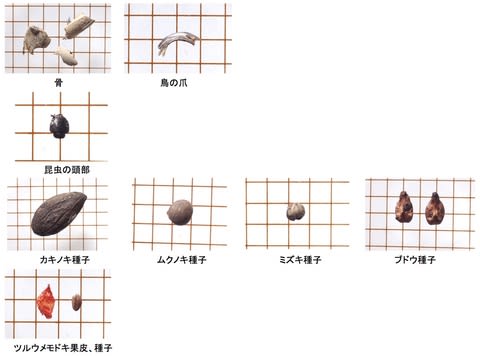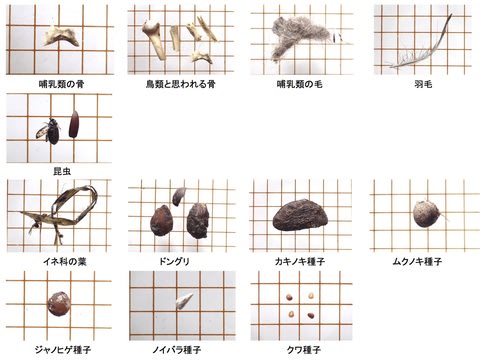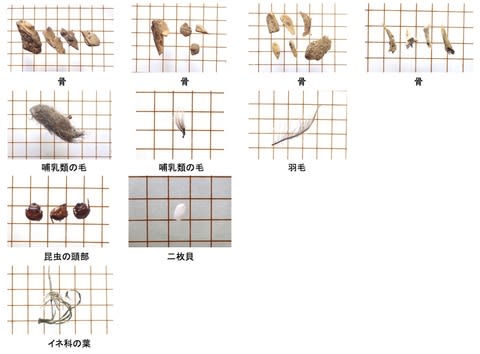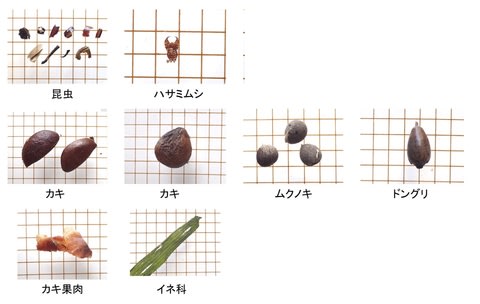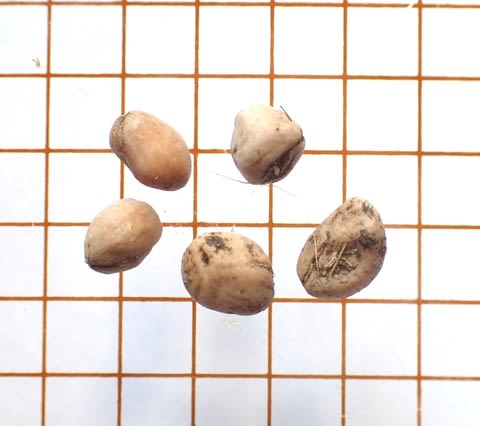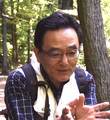Food habits of the raccoon dogs at Afan Wood, northern Nagano
Seiki Takatsuki
Studies on food habits of the raccoon dog have been biased to Kanto Area. There are of course unique studies such as an example on a small island of Kyushu (Ikeda et al. 1979), the southern island of Japan or an example on the coast of Sendai, northern Honshu, the main island of Japan (Takatsuki et al., 2017), or on mountain areas (Sasaki and Kawabata, 1994; Yamamoto, 1994). However, many of them were done at country sides or suburbs of big cities (Hirasawa et al. 2006; Sakamoto and Takatsuki 2015), or small greens in big cities (Sako et al., 2008, Akihito et al., 2016). In such habitats as in or around cities, the raccoon dogs show such food habits as they are dependent on fruits, with seasonal variation where they feed on insects in summer, mammal, birds or artificial foods in winter. Food compositions vary not only by seasons but also by habitats. This seems to reflect elastic nature of the raccoon dog.
In terms of elasticity, which characteristics the raccoon dogs at Afan Woodland have? Afan Wood is situated at the f northern part of Nagano. It is covered by deciduous broad-leaved forests (Quercus forest), accompanied by sugi Cryptomeria japonica plantation, pastures, or croplands. It is thus expected that the raccoon dog can utilize not only plants and animals in the Quercus forest but also crops or plants or animals in agricultural habitats.
Previous studies have shown the elastic nature in the food habits of the raccoon dog. It is true that the raccoon dogs show local variations affected by habitat differences. The elasticity is found not only spatially but also temporary, or they show yearly variations in food compositions. Nevertheless, most of the studies on the food habits of the raccoon dogs have been based on one-year data. Only one exceptioin is a study done at the Royal Palace for five years (Akihito et al. 2016). In this case, the food habits of the raccoon dog were stable through the five years, which seems to reflect the stability of food resources of the forest of the Royal Palace. Being different from the Royal Palace, the food conditions of Afan Woodland show clearer seasonality: the forest of the Royal Palace is dominated by evergreen trees whereas that of Afan Wood is dominated by broad-leaved trees. The latter often show yearly variations in fruit production, from which we expect yearly variations of the food habits of the raccoon dogs.
The objective of the present study is to show how the proportions of the foods of the raccoon dog afforded by Afan Wood and surrounding agricultural lands vary seasonally as well as yearly. For this objectives, we collected the fecal samples for six years. This report is a part of the long-term study and presents the results of 2018. Others will be reported later.
Area Studied
Afan Wood is situated at the north-eastern foot hill of Mt. Iizuna in Shinano Town, northern Nagano. It is covered by konara oak (Quercus serrata) forest which is weakly logged and the understories are regularly cleared. The adjacent forest to the north is a dark forest of sugi Cryptomeria japonica. The northern and eastern parts are covered by pastures or crop fields.
Methods
Droppings were collected almost all months from April to November every year. At latrines, only fresh dropping were sampled.

A raccoon dog defecating at a latrine at Afan Wood taken by a sensor-camera.

Droppings of raccoon dogs at a latrine at Afan Wood (June, 2018)
The samples were washed over 0.5 mm aperture sieve, and the retained materials were microscopically analyzed by the point-frame method (Stewart 1967). At least 100 counts were done for every sample. The category "fruit" means fleshy fruit. Although it was difficult to identify fruit coats, it was possible to identify seeds. "Artificial materials" include plastic bags, rubber, and others. "Crops" include rice, corn, and buckwheat.

Contents of a fecal sample washed over a sieve
Results
< General Compositions >
Droppings were mainly collected at two latrines. Collection was difficult during summer when dung beetles actively decomposed them. Fresh droppings found in May, 2018 were treated as May samples, but older ones below them were treated as "winter samples".
In the winter samples, crops, plant supporting organs, and mammals accounted for 20-30%. All the crops were rice, suggesting that the raccoon dogs went out the Afan Wood to feed on rice in the crop fields. Wild fruits occupied only small portions.
In May samples, mammals and other animals were abundantly recovered, suggesting the raccoon dogs fed on carcasses of mice and other mammals.
In June samples, mammal decrease while insects increased.
Samples were not available because of decomposition by dung beetles.
September samples and October samples were summed because of small sample sizes. The compositions greatly changed from those in early summer: animal materials decreased and plant materials such as fruits and mushroom increased. Seeds of Cornus kousa (yamaboushi) were abundantly found.
In December samples representing autumn foods were diverse: seeds accounted for 28.5%, and fruit coats, plant leaves, and crops accounted for around 10%.


Seasonal changes in the fecal compositions of the feces of the raccon dogs at Afan Wood, northern Nagano.
<Seeds>
Seeds increased in September-October where Cornus kousa (yamaboushi) accounted for greatly, followed by Vitis coignetiae (yamabudou). In December, as many as 9 species appeared: occupations were 6.1% for Actinidia arguta (sarunashi), 5.9% for Celtis sinensis (enoki), 3.4% for Magnolia kobus (kobush, 3.5% for Morus australis (yamaguwa), and 2.4% for Vitis coignetiae (yamabudou), Many fruit coats were unidentifiable, but those of Actinidia arguta (sarunashi) and Vitis coignetiae (yamabudou) were identified and abundantly recovered.

Seasonal changes in occupations of seeds recovered in the feces of the raccoon dogs at Afan Wood.
As crops, rice and buckwheat were recovered in winter.
Discussion
Winter foods of the raccoon dogs at Afan Wood were categorized by mammal carcasses and crops. These and abundance of plant supporting organs suggest that the raccoon dogs looked for these foods in the environment where fruits disappeared and foods were limited. In early summer, mammals and insects increased but fruits appeared less. Summer foods are not known because fecal samples were not available. In autumn, fruits became abundant, and insects decreased in the feces. Such clear seasonal difference as dominance of animal materials in spring and early summer and dominance of plant materials in autumn and winter seems a characteristic feature of the food habits of the raccoon dogs at Afan Wood.
Recoveries of rice and buckwheat in the samples of winter, June, and December suggest that the raccoon dogs went out the Afan Wood and entered crop fields to feed them on. Dependence of artificial materials was negligible.
In summary, the food habits of the raccoon dogs at Afan Wood are characterized by that they are mainly dependent on plants and animals in the forest as well as by that they use crops during winter when forest foods are limited.
References
Akihito, Sako T, Teduka M, Kawada S (2016) Long-term trends in food habits of the raccoon dog, Nyctereutes viverrinus, in the imperial palace, Tokyo. Bulletin of National Museum, Natural Science, Ser. A, 42:143-161
Hirasawa M, Kanda E, Takatsuki S (2006) Seasonal food habits of the raccoon dog at a western suburb of Tokyo. Mammal Study, 31:9-14
Ikeda H, Eguchi K, Ono Y (1979) Home range utilization of a raccoon dog, Nyctereutes procyonoides viverrinus, Temminck, in a small islet in western Kyushu. Japanese Journal of Ecology, 29:35-48
Sakamoto Y, Takatsuki S (2015) Seeds recovered from the droppings at latrines of the raccoon dog (Nyctereutes procyonoides viverrinus): the possibility of seed dispersal. Zoological Science, 32: 157-162
酒向 貴子, 川田 伸一郎, 手塚 牧人, 上杉 哲郎, 明仁 (2008) 皇居におけるタヌキの食性とその季節変動. 国立科学博物館研究報告A類(動物学), 34:63-75
Sasaki H, Kawabata M (1994) Food habits of the raccoon dog Nyctereutes procyonoides viverrinus in a mountainous area of Japan. Journal of Mammalogical Society of Japan, 19:1-8
Stewart DRM (1967) Analysis of plant epidermis in faeces:A technique for studying the food preferences of grazing herbivores. Journal of Applied Ecology, 4:83-111
山本 祐治 (1994) 長野県入笠山におけるテン, キツネ, アナグマ, タヌキの食性の比較分析. 自然環境科学研究, 7:45-52
山本 祐治, 木下 あけみ (1994) 川崎市におけるホンドタヌキの食物組成. 川崎市青少年科学館紀要, 5:29-34
Appendix


Representative food materials recovered from the droppings of the raccoon dogs at Afan Wood in 2018.














